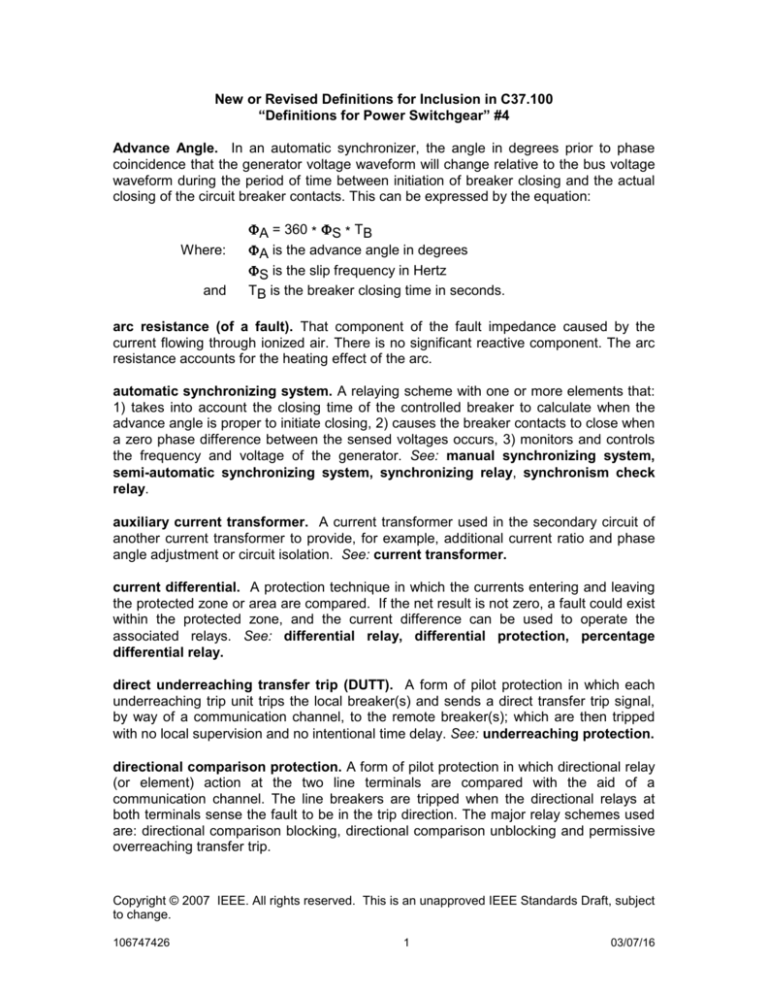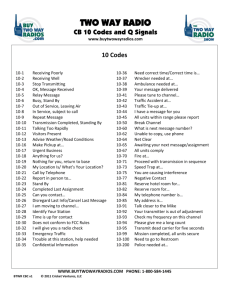
New or Revised Definitions for Inclusion in C37.100
“Definitions for Power Switchgear” #4
Advance Angle. In an automatic synchronizer, the angle in degrees prior to phase
coincidence that the generator voltage waveform will change relative to the bus voltage
waveform during the period of time between initiation of breaker closing and the actual
closing of the circuit breaker contacts. This can be expressed by the equation:
Where:
and
A = 360 * S * TB
A is the advance angle in degrees
S is the slip frequency in Hertz
TB is the breaker closing time in seconds.
arc resistance (of a fault). That component of the fault impedance caused by the
current flowing through ionized air. There is no significant reactive component. The arc
resistance accounts for the heating effect of the arc.
automatic synchronizing system. A relaying scheme with one or more elements that:
1) takes into account the closing time of the controlled breaker to calculate when the
advance angle is proper to initiate closing, 2) causes the breaker contacts to close when
a zero phase difference between the sensed voltages occurs, 3) monitors and controls
the frequency and voltage of the generator. See: manual synchronizing system,
semi-automatic synchronizing system, synchronizing relay, synchronism check
relay.
auxiliary current transformer. A current transformer used in the secondary circuit of
another current transformer to provide, for example, additional current ratio and phase
angle adjustment or circuit isolation. See: current transformer.
current differential. A protection technique in which the currents entering and leaving
the protected zone or area are compared. If the net result is not zero, a fault could exist
within the protected zone, and the current difference can be used to operate the
associated relays. See: differential relay, differential protection, percentage
differential relay.
direct underreaching transfer trip (DUTT). A form of pilot protection in which each
underreaching trip unit trips the local breaker(s) and sends a direct transfer trip signal,
by way of a communication channel, to the remote breaker(s); which are then tripped
with no local supervision and no intentional time delay. See: underreaching protection.
directional comparison protection. A form of pilot protection in which directional relay
(or element) action at the two line terminals are compared with the aid of a
communication channel. The line breakers are tripped when the directional relays at
both terminals sense the fault to be in the trip direction. The major relay schemes used
are: directional comparison blocking, directional comparison unblocking and permissive
overreaching transfer trip.
Copyright © 2007 IEEE. All rights reserved. This is an unapproved IEEE Standards Draft, subject
to change.
106747426
1
03/07/16
dropout (of a relay). That level of the measured quantity at which a sensing device will
just reset. See: pickup (of a relay), reset (of a relay).
fault impedance. The impedance at the point of the fault, which can include the
impedance of the arc, the fault initiating object and the tower footing resistance.
ground fault (transmission & distribution protective relays). An insulation failure
between an energized conductor and ground.
hardware failure. Inability of a relay to perform properly due to the malfunction of one
or more physical components, which must be replaced to correct the malfunction.
high impedance fault. A generic term used in protective relaying to identify a fault
condition in which the fault current magnitude is significantly lower than that caused by a
bolted fault. See: bolted fault, high impedance ground fault.
high impedance ground fault. See: high impedance fault.
high resistance fault. A high impedence fault, where the reactive component is small in
comparison to the resistive component.
inadvertent energizing. Accidentally energizing a generator that is off-line, with the
field de-energized.
manual synchronizing system. A control scheme whereby an operator controls the
generator voltage, frequency, and breaker closing. A group of instruments provides the
information required to make the closing decision. The operator’s action may be
supervised by additional devices that prevent incorrect closures. See: automatic
synchronizing system, semi-automatic synchronizing system, synchronism check
relay.
operator window (operator synchronizing window). A predetermined range of
voltage, phase angle and slip frequency within which an operator can safely initiate
closing of a circuit breaker to synchronize a generator to the system. See: automatic
synchronizing system, manual synchronizing system, semi-automatic
synchronizing system.
permissive overreaching transfer trip (POTT). A directional comparison pilot relaying
scheme in which the communication channel is keyed to a trip signal by an overreaching
relay. Tripping occurs when both a trip signal is received and a local overreaching relay
operates. See: overreaching protection.
phase angle regulator (regulating transformer). A high voltage phase shifter used
for power flow control, usually equipped with an exciting winding and a series winding,
requiring special relaying consideration differing from conventional transformer relaying.
pickup (of a relay). That level of the measured quantity at which a sensing device will
just operate. See: dropout (of a relay), reset (of a relay),
Copyright © 2007 IEEE. All rights reserved. This is an unapproved IEEE Standards Draft, subject
to change.
106747426
2
03/07/16
pole-mounted sectionalizing device. See: automatic line sectionalizer.
principle failure (of a relay). Inability of a relay to perform properly due to an
inaccuracy or error in the relay concept or algorithm. To correct the principle failure, the
relay must be conceptually redesigned.
recloser. See: automatic circuit recloser.
reset (of a relay). That state of a relaying function at which the output is in the same
state as when the relay is completely de-energized and unlatched. See: dropout (of a
relay), pickup (of a relay).
self-check. See: self-test.
self-monitor. See: self-test.
semi-automatic synchronizing system. A relaying scheme that has aspects of both
the manual and automatic synchronizing systems in that either one or the other will
match the generator or close the breaker, but not both. See: automatic synchronizing
system, manual synchronizing system.
slip frequency. The difference in frequency between two systems or between a
generator and the system. Slip frequency is per unit slip times rated frequency. For a
generator or motor, per unit slip is equal to the difference between the rated speed, N s,
and the actual speed, N, divided by the rated speed.
Slug. A metallic link or switch blade inserted in a fuse holder or mounting in an
electrical circuit to eliminate the fusing function.
split-phase protection. See: split winding.
steel armor. See: armored cable.
sync-check relay. See: synchronism check relay.
teleprotection. See: pilot protection.
trip window (unblocking or channel failure). A trip permission output generated by a
receiver after loss of channel (usually within 4 - 6 milliseconds) of 100 - 150 milliseconds
duration. This trip window is generated only on the loss of channel and not when the
channel is restored. The receiver logic requires that guard be restored and stable
before the trip window can again be generated.
tripping modes. This term describes the sequence of operations of the devices that
must trip in a relay scheme.
unblocking. A form of permissive overreaching transfer trip modified so that the
receiver will generate a trip time window that will permit local tripping if the local relay
Copyright © 2007 IEEE. All rights reserved. This is an unapproved IEEE Standards Draft, subject
to change.
106747426
3
03/07/16
sees a fault and a loss of channel.
transfer trip.
See: trip window, permissive overreaching
Revise Definition Currently in IEEE Dictionary:
pilot protection. [Add:] “Also called teleprotection.”
Copyright © 2007 IEEE. All rights reserved. This is an unapproved IEEE Standards Draft, subject
to change.
106747426
4
03/07/16









